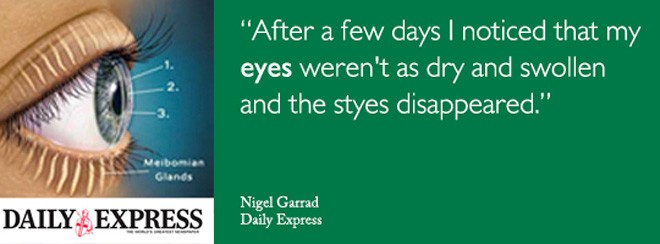Thermal Cure for Itchy Eyes – Daily Express

Barbara Lantin of the Daily Express talks to one of the first patients in the UK to try out a long-lasting solution for blepharitis.
Read the original article here.
By Barbara Lantin
Tuesday December 3rd, 2010
A new procedure that cures dry eye syndrome is being trialled on patients at a UK hospital in what is the first long-term treatment for the condition.
The technique is suitable for anybody who has a problem with the meibomian glands, tiny organs in the eyelid that produce oil to lubricate the eye.
When these glands fail, tears evaporate too quickly. The eyes then become dry, itchy and gritty. Blepharitis, which is inflammation of the eyelids, usually develops which means the lids become red, swollen and sore. Styes are also a complication.
Nigel Garrad, who works in event sales and lives in Copthorne, West Sussex, is one of the first people in the UK to undergo the new technique after suffering from inflamed lids and dry eyes for a year.

“I had redness inside the lids of my left eye and the eye felt itchy and looked puffy. You want to scratch the surface but you know that can make it worse.
“Sometimes it was quite swollen as if I’d been punched and I got a couple of styes too. The doctor gave me drops which helped with the irritation but the problem kept returning.
“You never know with an experimental treatment but it seems to have worked for me. After a few days I noticed that my eyes weren’t as dry and swollen and the styes disappeared. The crustiness went and it felt as if there was more lubrication.
“Prior to this I used artificial tears every day to prevent the feeling of dryness and I haven’t needed them at all.”
More than 150,000 people a year seek treatment for blepharitis and seven per cent of people in their 50s suffer from dry eyes. “Dry eye is a miserable condition affection comfort and vision” says Sheraz Daya, Consultant Ophthalmic Surgeon at Centre for Sight in East Grinstead, West Sussex, who has pioneered the new treatment in the UK.
“Patients complain of itching and burning eyes which are often worse in air-conditioned and windy places. They find they have to blink more often and their vision fluctuates.”
Convetional treatments include artificial tears as drops or a gel, steroid drops, antibiotic ointments and tablets and omega 3 capsules. “Eye hygiene” may also be recommended to loosen crusting. This involves putting warm compresses over the ey once or twice a day. You may have to stop wearing contact lenses and eye make-up.
According to the website NHS Choices, “blepharitis is a chronic condition which means that once it develops it can cause repeated episodes. There is no cure but establishing a daily eye-cleaning routine can help control the symptoms. This will need to be continued indefinitely.” Treatment can be time-consuming and tedious and, due to this, patients do not always follow their doctor’s instructions.
The new procedure known as LipiFlow thermal pulsation, was developed in America. So far there have been no published trials but studies carried out for US regulatory body the Food and Drug Administration (FDA) have shown some promising results. The tears of patients who have received LipiFlow evaporated more slowly and the meibomian glands worked more efficiently than patients on a regime of warm compresses. Almost four of the five patients had fewer dry eye symptoms. In some cases the effect lasted for up to nine months.
The technique takes 12 minutes and costs £500 per eye. First, patients undergo an assessment of their meibomian glands to see whether they are likely to benefit from treatment.
Next, a cup-shaped device is placed over the eye. An inner layer warms the insides of the lids gently to 42.5C while keeping the eye cool. An inflatable outer layer puts pressure on the outer lids.
“Once the lids are warmed up the device squeezes them and pushes out the stagnating oil within the meibomian glands and also opens the pores of the glands,” explains Mr Daya, whose team has carried out LipiFlow on eight patients including Mr Daya’s ophthalmologist wife, Marcela.
“This clear-our helps start a process of improvement which continues to progress over time.” he adds.
Nigel Garrad describes the procedure as feeling “strange but not uncomfortable.” He says: “It feels a bit like wearing contact lenses.
“There are two pads on the top and bottom lids which heat up and inflate and dflate to massage the lid from the inside. I couldn’t feel any heat on the eyeball itself. It was a bit of a surprise when the pads inflated completely but it was painless.
“It worked for me. My eyes feel more comfortable than they have for a long time.”
Author Information
Authored by Sheraz Daya MD FACP FACS FRCS(Ed) FRCOphth, Consultant Ophthalmic Surgeon & Medical Director, June 2019.
Next review due June 2020.
